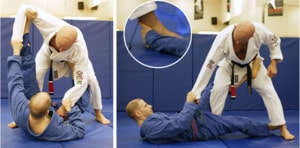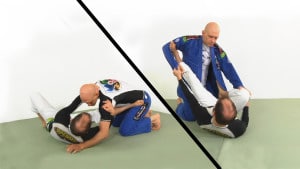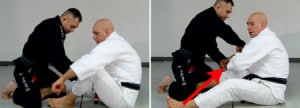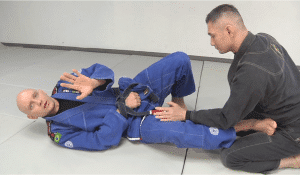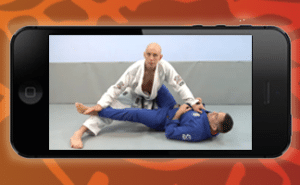“My Fingers Hurt…”
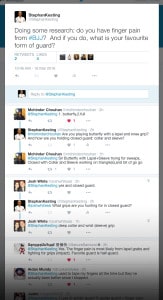 I get a lot of emails, tweets and messages from BJJ practitioners about fingers hurting all the time.
I get a lot of emails, tweets and messages from BJJ practitioners about fingers hurting all the time.
For example, I asked a question about BJJ hand pain on Twitter got a ton of responses (click here to see them on Twitter), including a disconcerting number of white belts who had this problem.
So it’s a real problem, and not only for people who’ve been doing the sport a long time.
The bottom line is that BJJ involves a lot of gripping, clasping and holding, which means the fingers do sometimes take a beating.
Occasional soreness is acceptable – it’s part of the adaptation process and to be expected (just like sore legs after squatting). What’s important is that it doesn’t become a chronic situation where you’re in pain all the time!
In this article we’ll first look at some of the worst case finger pain scenarios. Then we’ll move on to some solutions to prevent your hands from taking real long-term damage.
It stands to reason that the more training you do, and the more gi-dependent your game is, then the greater your risk of finger problems becomes. So without a doubt, the guys most at risk are professional jiu-jitsu competitors…
Finger Damage and Professional Grapplers
Consider the Miyao brothers: both twins are BJJ black belts that spend a crazy amount of time on the mats: training all the time with no other hobbies, competing weekend after weekend without a break, and possessed of a notorious disregard for their own orthopaedic safety. (I know we’re talking about fingers and not feet in this article, but for proof check out Joao Miyao basically ignoring a fully applied toehold at 1:18 of this match.)
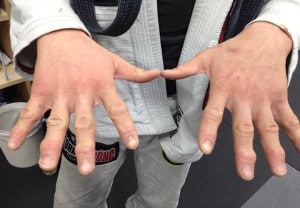 The dude isn’t any easier on the rest of his body either. Have you seen the that famous photo of 24 year old Joao Miyao’s hands from the wrists down?
The dude isn’t any easier on the rest of his body either. Have you seen the that famous photo of 24 year old Joao Miyao’s hands from the wrists down?
You don’t need to be a doctor know that the swollen knuckles, bumps, bunions and bruises aren’t a good sign…
Imagine what his hands are going to feel like when he’s 60!
And he’s far from the only one…
Keenan Cornelius (speaking as ‘Fritzdagger’ on a Reddit AMA) asked about his injuries, said that of everything he’s been through, “My fingers hurt the most.“
Later on his Facebook page Keenan also said,
“Coming up on a decade of Jiu-Jitsu, these hands have taken a beating. I would say I’ve lost about 20% of the mobility in my fingers. I can’t make a closed fist anymore which has forced me to use bas rutten open palm self defense strikes when things go sour in the streetz. I spend about 60 dollars a year in tape (buying in bulk) multiple sprains, an evulsion fracture and countless torn knuckles. I’m proud of what they have become, gnarled claws from 10 years of choking and gripping and grasping. Here’s to the next decade of mangled digits.“
So far all the examples have been anecdotal (one cherry-picked guy who says this, another cherry-picked guy who says that)…
But there’s even been some scientific research about this topic…
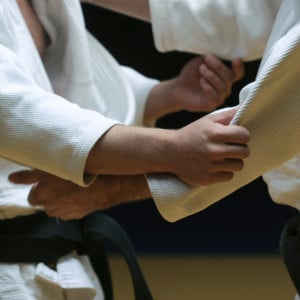 In modern Judo gripfighting is incredibly important. If a high level Judo competitor gets his preferred grip then he’ll almost certainly throw his opponent.
In modern Judo gripfighting is incredibly important. If a high level Judo competitor gets his preferred grip then he’ll almost certainly throw his opponent.
Thus the whole battle in Judo is to prevent your opponent from getting his grips while establishing your own.
So there’s always lots of gripfighting, along with all the attendant wear and tear on the fingers.
Given the pounding that the hands take in Judo it shouldn’t be too surprising that when researchers studied 10 members of the Swiss national Judo team they found lots of hand damage.
In fact the study found that ALL of the athletes – 10 out of 10 judoka – had “more or less severe osteoarthrosis” in their fingers. This means the judoka had lesions and calcific spurs of the finger joint cartilage, visible on both clinical examination and on X ray.
This is pretty worrying for the rest of us…
How to Prevent Finger Pain in BJJ
Before everyone panics and quits BJJ forever let’s move on to some finger pain solutions.
Trading finger function for tournament trophies may be an acceptable tradeoff if you’re a professional BJJ competitor, but it’s not really acceptable for most recreational players.
Typing on a keyboard, tying your shoelaces, and brushing your teeth may ultimately be more important than winning another gilded plastic trophy to gather dust in your closet.
It’s significant that Joao Miyao, Keenan Cornelius, and all the members of the Swiss national Judo team aren’t representative of the average practitioner.
They train more in a single day than most people do in a week (or a month)… And spar against tougher opponents… And exercise at a higher level of intensity… And they have very grip-dependent styles of competition… And train through injuries that would force ‘normal’ people to take a break…
So if your fingers take some damage it’s not likely to be as severe as these guys (unless you’re an idiot about it).
So let’s take a look at what you can actually do to prevent BJJ finger damage…
1) Spare the Fingers Part 1: Play Less Grip-Dependent Guards
Certain kinds of guards are just harder on the fingers than others. That means you can limit the wear and tear on your fingers by adjusting, or at least varying, the style of guard you use.
In my experience the worst offender for finger pain is the Spider Guard, closely followed by certain styles of de la Riva Guard (two styles of guard favoured by Keenan Cornelius and Joao Miyao, incidentally).
In both Spider and de la Riva Guard you have to maintain sleeve grips against an opponent strongly motivated to get rid of them. So that means lots of struggle, lots of strain, and the potential for damage.
This is too bad because both the Spider Guard and the de la Riva Guard are incredibly powerful sweeping and submission platforms, and contribute heavily to the modern jiu-jitsu arsenal (which is, of course, why they’re used by so many of the top competitors).
Does that mean that Spider Guard inevitably leads to mangled fingers? Not at all!
Does it mean that I’m advising you not to play Spider Guard? Nope – it’s very effective, and I use it in my own game.
All I’m saying is that if your fingers are hurting then give the Spider Guard a rest for a little while. You do have other effective choices!
The Closed Guard, Butterfly Guard and Half Guard can be finger friendly choices. Especially if you relay more on overhooks, underhooks and head control instead of various forms of sleeve and lapel grip.
I’m not telling you to avoid Spider Guard or de la Riva Guard. If you use them and your hands don’t hurt then that’s awesome – keep on going!
Also there are ways to do the Spider and de la Riva Guard that are more finger friendly. The pistol grip, for example, controls your opponent’s sleeve almost as well as the standard hook grip, but is way easier on your hands if your opponent goes full Cro-Magnon and rips his arm free.
Once again: if you’re in chronic pain from swollen fingers then take a vacation from Spider Guard and work a different form of guard for a while.
2) Spare the Fingers Part 2: Train No Gi, At Least Some of the Time
In my experience, almost all grapplers with chronically sore fingers seem to train primarily with the gi. So one obvious solution to sore fingers is to do more training without the gi.
Too many people think that gi vs no gi is an uncrossable chasm, and that you have to do one or the other.
This is completely incorrect: in no gi you’ll still develop many of the attributes essential to jiu-jitsu: timing, sensitivity, leg dexterity, speed, and technique (only you’ll be doing it without death grips on your opponent’s sleeves or lapels).
You don’t have to do one or the other: you can divide your time between both. One of my jiu-jitsu idols – Marcelo Garcia – is known for training 50% gi and 50% no gi. Perhaps not coincidentally his game is centered around the Butterfly guard, X Guard and Single Leg X Guard, all of which work well in both arenas.
A completely gi-dependant game is also a poor choice if you care about your self defense skills. You need options to defend yourself if your attacker is wearing a T shirt and jeans, and those are best trained by occasionally rolling in without your gi on.
Finally no gi develop your non-grip-dependent submissions. Instead of only training death grip collar chokes and potentially digit-crushing sleeve chokes you’ll refine your finger-friendly armbars, rear naked chokes, guillotines, omoplatas, north-south chokes, Kimura armlocks, etc.
Spare your fingers and diversify your game – train more no gi!
3) Don’t Fight to the Death for the Grips
The damage to your fingers might not be from the gripping itself – it might be the grip breaking your opponent is doing!
Many gripfighting grip breaks are sharp, snapping movements. Sometimes they involve using the power of the legs against the hands. And people can even use clubbing style strikes to get your hands off of them (like the forearms strike in this guard retention article).
All this straining, impact and ripping free of grips can really take a toll on your hands…
If your style of guard play is heavily grip dependent then maybe don’t fight to the death for those grips.
For example, if you’re in Spider Guard and your opponent manages to plant his foot on your thigh then you already know what’s coming next! He’s going to stomp down, posture up, and rip his arm free. Yes, if you grimly hang on you may be able to prevent that grip strip, but at what cost? Is it really worth an injury just to maintain your Spider Guard?
If it looks like you’re going to lose a grip anyway then just let it go and move on to another position. It might be hard on your ego, but it’ll be way easier on your fingers.
4) Do the Right Thing If You Injure Your Hands
Alright, now you’ve done it. You fought like a maniac to hang onto that sleeve (or lapel, or pant leg) and now one or more of your fingers are jacked.
Well I’m no doctor, but I’m pretty sure that the answer for an injured joint ISN’T to go right back and do the same thing that injured it in the first place.
The standard advice applies…
- REST. Give your hands a break. Start experimenting with that other style of guard you’ve never dedicated time to before. Or start training your guard with only one hand – it’s actually kind of fun and will greatly improve your leg dexterity
- ICE. Apply cold packs to your hands and fingers, or short ice baths. Don’t overdo it: you just want to bring down the swelling, not give yourself frostbite!
- COMPRESSION AND ELEVATION. These are a little harder to pull off with hands than with other body parts, so they probably won’t be your mainstay of treatment. But compression does have a lot of similarities to taping, which we’ll cover below.
-
ANTI-INFLAMMATORIES. Some grapplers refer to Ibuprofen as ‘Vitamin I’ because it soothes their chronically sore bodies. While I think that Ibuprofen and other NSAIDS (non-steroidal anti-inflammatories) have their short term uses for managing recent injuries, using them in heavy doses or for a long time is really dangerous. They are NOT supplements to be swallowed everyday!! If you don’t believe me try googling the words “ibuprofen kidney failure” and see how many results you get

Finally – and this is important – if your hands or fingers are truly injured (not just sore for a day or two) go see a hand specialist.
Your family doctor doesn’t have the specialised training to interpret detailed X rays. The ER resident at the hospital only cares about whether your lungs are inflating properly and your heart is beating.
Consider these non-specialist doctors as gatekeepers: what you want out of them is a referral to a orthopaedic hand specialist who can correctly diagnose and then appropriately treat you. That’s the fastest way to get back on the mats.
5) Tape Your Fingers
A lot of judo and jiu-jitsu players tape their fingers, and for good reason. It’s really seems to protect the fingers from the slings and arrows of excessive gripping!
Because my style of jiu-jitsu isn’t very grip dependant I’m not religious about taping my fingers. I tell myself that I’m relatively safe from potential damage. And so far it seems that I’m mostly right…
That being said, I did do an interesting experiment recently where I taped the fingers of one hand and not the other before a training session. After we finished and I removed the tape I was startled to feel the difference between the two hands: one was sore, the other not.
I guess I hadn’t realised how much strain even a ‘non-grip dependant’ training session can put on the fingers.
Below is a step-by-step video guide to taping your fingers for BJJ. Once you’ve done it a few times it’s actually a pretty easy process…
So now you should be aware of the problem of finger pain in BJJ, as well as having 5 concrete steps to reduce the risk and fix the damage should it occur.
Good luck with your training!
Stephan Kesting
Additional Resources
- Our FREE Roadmap for BJJ instructional video app for your smartphone or tablet. This app will make sure you build your BJJ on a solid foundation by giving you both the big picture and the little details to succeed. Click here for more info about this app for Apple, Android and Kindle devices.
- The Grapplearts email newsletter. This is a very popular feature and for good reason: sign up and you’ll get tons of solid tips, tricks and techniques delivered straight to your inbox. If you don’t like what you get then there’s an unsubscribe button at the bottom of every email and you’ll never hear from us again. Click here for more information about the newsletter.
- The Most Powerful Guard for Sweeping. A video explaining why the Butterfly Guard may be the most powerful guard when it comes to getting from the bottom to the top in BJJ. Click here to view this free video.
The post Finger Pain in BJJ and What to Do About It appeared first on Grapplearts.

